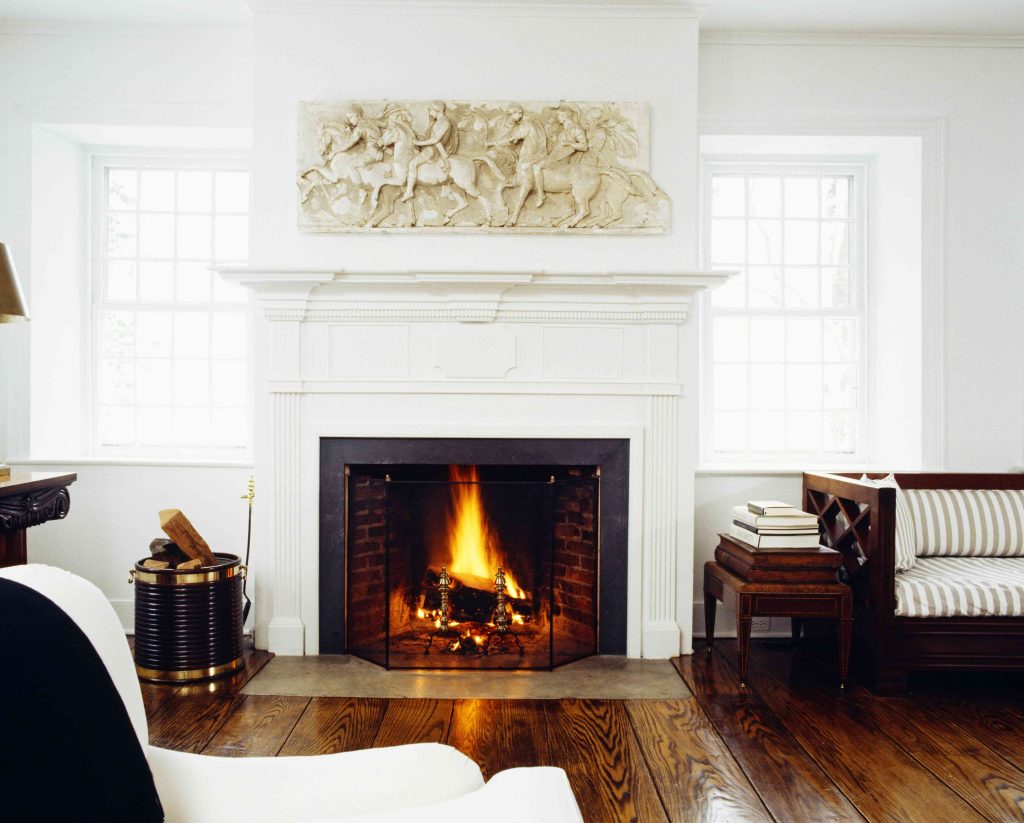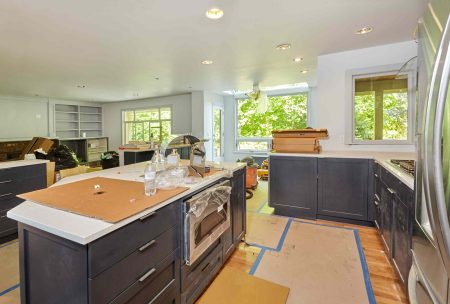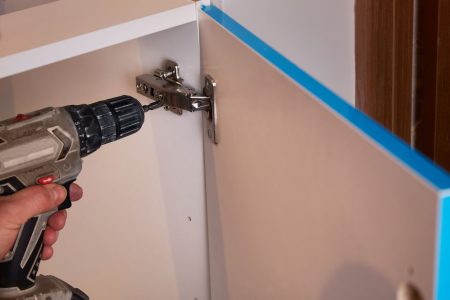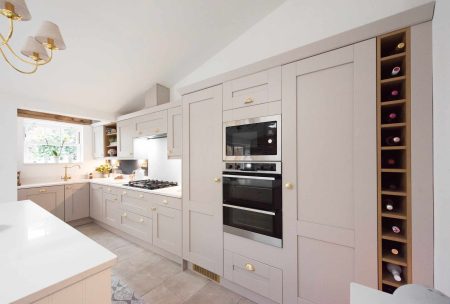Whether you’re redoing an existing fireplace or adding an entirely new fireplace to your home, you may be caught off guard by the numerous types of fireplaces you can choose from. The four common types of fireplaces include wood-burning, gas, electric, and ethanol, but each one of these fireplace categories includes additional subcategories. This can make choosing the right type of fireplace more confusing than it should be.
To help you understand the difference, we’ve broken down the common types of fireplaces and their pros and cons so that you can make an informed decision.
Types of Fireplaces
Choosing a fireplace is more than simply choosing what you want your home to look like. Choosing between options like wood-burning, gas, electric, and ethanol fireplaces can drastically impact the upfront cost of installation, the long-term cost of operation, and even the comfort of your living space.
Want more home reno project tips and inspiration? Sign up for our free daily newsletter for the latest how-tos, reno guides, and more!
Wood-Burning Fireplaces
Wood-burning fireplaces are what many picture when they imagine a fireplace, as they’ve been around for ages. You can probably even imagine the smells and sounds of the wood burning.
While there’s no doubt that wood makes for a great fuel source for a fireplace, wood fireplaces are expensive and require consistent maintenance and upkeep to keep them safe and operational.
Though you can’t beat the comfort and charm that comes with the crackle of a wood fireplace, you can beat the efficiency of a wood fireplace at a much lower cost. However, if you own or have access to wooded land, a little sweat can afford you an abundant heat source.
Types of Wood-Burning Fireplaces
- Open-hearth: Open-hearth wood fireplaces are the most traditional type of wood fireplaces, with a wide-open design that utilizes the room’s air for combustion. While they are often the most beautiful fireplaces, they are among the least efficient.
- Closed-hearth: Closed-hearth fireplaces have a sole focus: heating your home. The closed design allows them to heat up to 10 times more efficiently than open-hearth wood fireplaces, but they lack the charm and aesthetics.
- Wood fireplace inserts: These inserts can be placed into an existing fireplace to improve its safety and efficiency.
- Prefabricated: These are simply wood-burning fireplaces that are constructed offsite.
-
Beautiful appearance
-
Can add value to your home
-
Charming sound, sight, and smell during operation
-
An abundant free fuel source if you own or have access to wooded property
-
High-maintenance
-
Screens must be used to prevent ash and embers from exiting the fireplace
-
Can be dangerous if installed improperly or not maintained
-
Expensive installation
-
Not as efficient as other fireplace options
How Much Do Wood Fireplaces Cost?
Wood fireplaces can be a relatively inexpensive heat source, but they can be expensive upfront. While installation could be as little as $700, more involved installations can top $30,000.However, the average cost of a wood fireplace installation is $2,499.
Gas Fireplaces
Gas fireplaces are a wildly popular home heating option. While many new construction homes are outfitted with gas fireplaces, conversion gas fireplace inserts are often used to bring new life to old wood-burning fireplaces that are either unsafe or simply not wanted.
If you’re unfamiliar, “gas” refers to natural gas, which is a more efficient fuel source for a fireplace than wood. If your home already has natural gas utilities, it can be relatively easy to install a gas fireplace.
The most popular types of gas fireplaces are vented gas fireplaces and ventless gas fireplaces. Vented gas fireplaces are more similar to wood-burning fireplaces, as they utilize a chimney or similar component to vent the firebox. On the other hand, ventless gas fireplaces require no venting, as the gas burns cleanly and doesn’t produce carbon monoxide.
Types of Gas Fireplaces
- B-vent: B-vent natural gas fireplaces utilize the air from the room for combustion, then vent it through a double-wall pipe connected to a chimney.
- Direct vent: Instead of using a chimney, a direct vent gas fireplace pulls in combustion air from outside, then releases it back outside.
- Ventless: Ventless gas fireplaces have no vent. Instead, they combust the interior air, which allows them to more efficiently circulate heat throughout the space. Because they require no ventilation or chimneys, they can be installed in nearly any space.
-
Higher energy efficiency compared to traditional wood-burning fireplaces
-
Fewer harmful emission than wood-burning fireplaces
-
Low maintenance
-
Still burns a real flame, unlike electric options
-
Your heat relies on gas supply, which could go out
-
Higher upfront cost than some other fireplace options
-
Vented gas fireplaces require ventilation, which will need to be added if not already present in the home
-
Gas leaks are possible, though rare
How Much Do Gas Fireplaces Cost?
A gas fireplace installation can be significantly cheaper than a wood-burning fireplace installation, but you should still plan on spending between $2,500 and $10,000.Installation of a conversion gas fireplace unit can save you money if you currently have a compatible wood-burning fireplace, with an average price of $3,000.
Electric Fireplaces
Electric fireplaces are the quickest and easiest type of fireplaces to install. Similarly, they’re often the easiest to operate. Most electric fireplaces can be mounted on the wall and plugged into a standard outlet, offering a near-immediate heat source.
Many electric fireplaces are even designed to be portable, so you can easily move them from room to room. Because they can be plugged into standard outlets, this makes it easy to quickly increase the comfort of whichever room you’re using.
Electric fireplaces are generally inexpensive to install and operate, but they aren’t directly comparable to gas and wood-burning fireplaces. The main drawback of an electric fireplace is the lack of a real flame—something many consumers are looking for in a fireplace. Additionally, they’re not helpful during a power outage, whereas a gas or wood-burning fireplace would still be operational.
Types of Electric Fireplaces
- Wall-mounted: Wall-mounted fireplaces are permanently mounted on the wall.
- Inset: These electric fireplaces are mounted in the wall rather than on it, which leads to a more involved, often costlier installation.
- Stove-style: These electric fireplaces can be moved from room to room and mimic the look of an old wood-burning stove.
- Basket-style: These electric fireplace units mimic the look of antique cast-iron fire baskets.
- TV stand: While this type of electric fireplace may seem confusing, it’s simpler than it seems. These are just TV stands with integrated electric fireplaces.
-
Very easy installation
-
Very energy efficient with no heat loss
-
Low maintenance and incredibly safe
-
Easily adjustable to your preferences
-
Doesn’t burn a real flame
-
Doesn’t offer as much heat as gas or wood
-
No heat source during a power outage
-
Not as pleasant as a wood-burning fireplace, as their are no aromas, smells, or sights
How Much Do Electric Fireplaces Cost?
With electric fireplaces, you don’t have to worry about the high installation costs associated with gas and wood-burning fireplaces, as they don’t actively burn a fuel source. In most cases, they can simply be mounted and plugged in, significantly reducing the upfront costs. On average, electric fireplaces cost $700, but prices can range from $200 to $10,000, as many styles of electric fireplaces are available.
Ethanol Fireplaces
Ethanol fireplaces are a modern heating solution that utilizes an incredibly clean-burning fuel source. A relatively new fireplace option, you may also see them marketed as bio fireplaces or bioethanol fireplaces.
The fireplace’s fuel source, ethanol, is an alcohol-based fuel that’s most commonly derived from corn. Ethanol burning emits a real flame without the harmful emissions that come with other fireplace fuel sources. As a result, ethanol fireplaces don’t require ventilation.
Types of Ethanol Fireplaces
- Freestanding: Much like portable electric fireplaces, these lightweight ethanol fireplace options can be moved from room to room.
- Tabletop: Smaller portable ethanol fireplaces are designed to be used on a tabletop for ambiance and fun activities, such as roasting marshmallows.
- Built-in: Ethanol fireplaces can also be built into the wall permanently, much like a gas fireplace. These integrated fireplace options often feature a glass front.
- Wall-mounted: Wall-mounted ethanol fireplaces offer a similar look to built-in ethanol fireplaces, with an easier, less-invasive installation.
-
No ventilation required
-
More design options
-
Low maintenance
-
Clean-burning
-
Real flame
-
Lower heat production compared to other fireplace options
-
Bioethanol fuel source is more expensive than gas or wood
-
Limited flame control
-
Not as safe as gas or electric
How Much Do Ethanol Fireplaces Cost?
Ethanol fireplaces are some of the most affordable when it comes to upfront costs, as installation costs average between $700 and $1,400.However, because ethanol costs more than other fuel sources, the long-term operation costs may level out the total cost of the fireplace.
How to Choose the Right Fireplace for Your Home
So, now that you know the key differences between wood-burning, gas, electric, and ethanol fireplaces, how do you decide which is right for your home? Here are the factors you should consider:
- Installation costs. One of the most important factors in choosing the best fireplace for you is budget, as the costs associated with these different fireplaces vary greatly. Once you’ve established how much you want to spend, then you can explore the options that fit your budget.
- Operational costs. Each type of fireplace on this list utilizes a different type of energy to create heat and each of these fuel sources costs money. Even wood, which seems cheap (or free if you have timber on your property) requires a lot of physical labor, which you may not have time or energy for.
- Maintenance. You should also consider how much maintenance you plan on performing throughout the year, as each type of fireplace has a different set of maintenance needs. For instance, wood-burning fireplaces require a lot of cleaning and maintenance, while electric fireplaces require little to no maintenance.
- Utility access. Before you get your heart set on a gas fireplace, check with your utility company to ensure your home can access gas utilities.
- Building codes. A wood-burning fireplace is a beautiful addition to a home, but some building codes don’t allow them. Check your local codes before making plans.
- Ventilation. Many fireplaces on this list require ventilation, such as gas and wood-burning. This can limit where a fireplace can be put in your home or if it can be installed at all.
-
What’s the easiest fireplace to install?
A wall-mounted electric fireplace is the easiest fireplace to install and can easily be done by any level of DIYer. Most wall-mounted electric fireplaces don’t require hardwiring to a circuit and can simply be plugged into an electrical receptacle.
-
Which type of fireplace puts out the most heat?
Gas fireplaces are considered the most efficient for heat transfer. They have higher BTUs than wood-burning fireplaces and don’t require a chimney, where much of a wood-burning fireplace’s heat is lost. Ventless gas fireplaces are among the most efficient types, as they continually circulate heat throughout the room with little to no loss.
-
What fireplace is the most cost-effective?
Electric fireplaces are often considered the most cost-effective fireplaces, as the combined cost of the unit, the installation, and the operation is lower than that of gas and wood-burning fireplaces. This lower cost is mostly due to the less-involved installation of electric fireplaces, as many of them can simply be mounted to a wall and plugged into an outlet.
Read the full article here









